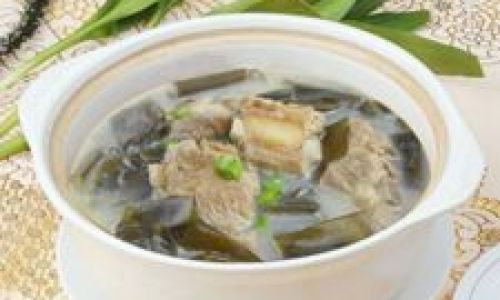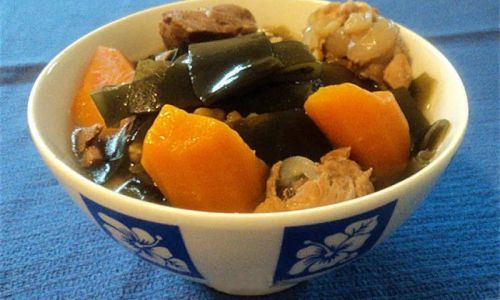Introduction
In the sweltering heat of summer, few beverages rival the cooling embrace of a chilled, nourishing soup. Among the myriad traditional recipes that have stood the test of time, ice-cold seaweed and mung bean soup emerges as a beloved classic. This vibrant green elixir, rooted in East Asian culinary traditions, combines the earthy sweetness of mung beans with the briny depth of seaweed, all harmonized by a delicate sweetness and served frosty cold. Beyond its refreshing qualities, this soup boasts a wealth of health benefits, making it a staple in households across China, Vietnam, Korea, and beyond. Whether you seek respite from the sun, a detoxifying boost, or a taste of cultural heritage, this recipe promises to deliver. Join us as we explore the intricacies of crafting this timeless treat, from selecting the finest ingredients to mastering the perfect balance of flavors and textures.
The Cultural Tapestry of Seaweed and Mung Bean Soup
Before diving into the recipe, it’s essential to appreciate the cultural significance of this dish. In traditional Chinese medicine (TCM), mung beans (Lüdou) are revered for their “cooling” properties, believed to counteract internal heat and promote detoxification. Similarly, seaweed—often referred to as the “ocean’s vegetable”—is prized for its mineral-rich profile, including iodine, iron, and calcium. Together, these ingredients form a symphony of nutrition and flavor, embodying the philosophy of yin and yang by harmonizing land and sea.
In modern times, this soup has transcended cultural boundaries, becoming a global favorite in health-conscious communities. Its versatility allows for endless adaptations, from vegan-friendly sweeteners to exotic additions like coconut water or pandan leaves. Yet, at its core, the recipe remains a testament to simplicity and the belief that wholesome ingredients need little embellishment.

Ingredients: Assembling the Building Blocks
To create a batch of ice-cold seaweed and mung bean soup that serves 6–8 people, gather the following ingredients:
- Mung Beans (100g/½ cup): Opt for whole, unpolished beans for maximum nutritional value. Their vibrant green hue will infuse the soup with color.
- Dried Seaweed (8g/0.3 ounces): Look for varieties like kombu (kelp) or wakame, which rehydrate beautifully. Avoid overly salty or artificially flavored options.
- Water (1.5 liters/6 cups): Use filtered water to ensure clarity and purity of flavor.
- Sweetener (To taste): Rock sugar, honey, or agave syrup complement the soup’s earthiness without overpowering it.
- Optional Enhancements:
- Fresh mint leaves (for garnish)
- Lemon wedges (for a citrusy twist)
- Tapioca pearls (for texture contrast)
Equipment Checklist
- A heavy-bottomed pot (3–4 liters capacity)
- A fine-mesh strainer
- A wooden spoon
- A large mixing bowl (for soaking)
- A pitcher or airtight container (for chilling)
Step-by-Step Preparation: From Soak to Serve
Soaking the Ingredients: The Foundation of Flavor
Begin by rinsing the mung beans under cold water to remove any debris. Transfer them to a bowl and cover with 2 cups of water. Allow them to soak for at least 2 hours, or preferably overnight. This step softens the beans, reducing cooking time and ensuring even texture.

Meanwhile, prepare the seaweed. If using dried kombu, wipe it gently with a damp cloth to remove excess salt (do not rinse, as this washes away beneficial compounds). For wakame or similar varieties, submerge them in a separate bowl of cold water for 10–15 minutes until pliable. Once rehydrated, drain and slice the seaweed into thin strips or small squares, discarding any tough stems.
Cooking the Mung Beans: Achieving Perfect Tenderness
Drain the soaked mung beans and transfer them to the heavy-bottomed pot. Add 1.5 liters of fresh water and bring to a rolling boil over medium-high heat. Skim off any foam that rises to the surface—this step ensures a clearer broth.
Reduce the heat to low, cover the pot, and simmer gently for 30–40 minutes. Stir occasionally to prevent sticking. The beans are ready when they split open easily, revealing a soft, fluffy interior. Avoid overcooking, as this can result in a mushy texture.
Incorporating the Seaweed: Balancing Brine and Sweetness
Once the mung beans are tender, add the rehydrated seaweed to the pot. Stir gently to combine. The seaweed will soften further as it simmers, releasing its umami-rich flavors into the soup. Cook for an additional 5–7 minutes, then remove the pot from heat.

Sweetening to Perfection: A Delicate Dance
Now comes the critical step of sweetening. Add your chosen sweetener gradually, tasting as you go. Rock sugar, a traditional choice, dissolves slowly and imparts a subtle caramel note. Honey or agave offers a floral sweetness, while date syrup adds depth. Aim for a balance where the sweetness enhances the beans and seaweed without becoming cloying.
Chilling the Soup: Patience Rewarded
Allow the soup to cool to room temperature before transferring it to the refrigerator. Chill for at least 4 hours, or until thoroughly cold. For an extra-refreshing treat, pour the soup into ice cube trays and freeze; these cubes can be added to glasses to keep the soup cold without dilution.
Serving Suggestions: Elevating the Experience
When ready to serve, ladle the chilled soup into bowls or glasses. Garnish with fresh mint leaves, a squeeze of lemon, or a sprinkle of toasted sesame seeds. For added texture, consider layering in cooked tapioca pearls or diced tropical fruits like mango or lychee.
Tips for Success: Avoiding Common Pitfalls

- Soak Smartly: Overnight soaking reduces cooking time and ensures even texture. If short on time, use hot water for a 1-hour quick-soak.
- Mind the Heat: Maintain a gentle simmer to prevent the beans from breaking apart. A heavy-bottomed pot distributes heat evenly, minimizing scorching.
- Sweeten Strategically: Always taste and adjust sweetness after cooking, as the beans absorb flavors differently when hot versus cold.
- Seaweed Selection: Avoid overpowering varieties. Kombu adds depth, while wakame offers a milder flavor.
- Storage: The soup keeps refrigerated for up to 3 days. Freeze portions for up to a month.
Variations: Exploring Global Flavors
- Coconut Infusion: Replace 1 cup of water with coconut water for a tropical twist.
- Herbal Notes: Add a pandan leaf or strip of lemon zest during cooking.
- Spicy Kick: Serve with a side of chili oil or sliced jalapeños for contrast.
- Vegan-Friendly: Use agave syrup or maple syrup instead of honey.
Health Benefits: More Than Just a Refreshing Treat
- Detoxification: Mung beans contain antioxidants that support liver function and combat free radicals.
- Hydration: The soup’s high water content replenishes electrolytes lost through sweating.
- Mineral Boost: Seaweed provides iodine, essential for thyroid health, and iron for energy.
- Digestive Aid: The fiber in mung beans promotes gut health, while seaweed’s gelatinous texture soothes the stomach.
Troubleshooting Guide: Fixing Common Issues
- Mushy Beans: Reduce cooking time next batch or soak beans longer.
- Bitter Aftertaste: Ensure thorough rinsing of beans and seaweed to remove impurities.
- Cloudy Broth: Avoid boiling vigorously; maintain a gentle simmer.
- Overly Sweet: Balance with a splash of lime juice or a pinch of sea salt.
Pairing Suggestions: Beyond the Bowl

- Savory Pairings: Serve alongside dumplings, spring rolls, or grilled tofu for a balanced meal.
- Sweet Pairings: Pair with almond cookies or coconut milk pudding for dessert.
- Beverage Pairings: Enjoy with jasmine tea or chilled green tea for an authentic experience.
Conclusion: A Timeless Elixir for Modern Times
In an era of fleeting trends, the ice-cold seaweed and mung bean soup endures—a testament to the power of simplicity and tradition. Whether you seek relief from summer’s heat, a nutrient-packed snack, or a culinary adventure, this recipe invites you to slow down, savor, and connect with centuries of wisdom. With practice, you’ll master the delicate balance of flavors, transforming humble ingredients into a symphony of refreshment. So fire up the stove, embrace the soak, and let the chilled embrace of this soup transport you to shaded verandas and timeless kitchens. Here’s to cool sips and warmer days!






0 comments